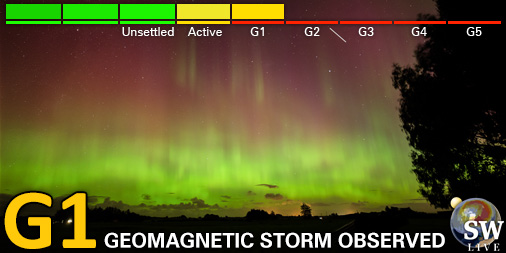Viewing archive of Thursday, 15 May 2003
Geophysical report
Any mentioned solar flare in this report has a scaling factor applied by the Space Weather Prediction Center (SWPC). Because of the SWPC scaling factor, solar flares are reported as 42% smaller than for the science quality data. The scaling factor has been removed from our archived solar flare data to reflect the true physical units.
Solar and Geophysical Activity Summary 2003 May 15 0245 UTCPrepared by the NOAA © SWPC and processed by SpaceWeatherLive.com
Joint USAF/NOAA Solar and Geophysical Activity Summary
SGAS Number 135 Issued at 0245Z on 15 May 2003 This report is compiled from data received at SWO on 14 MayA. Energetic Events
Begin Max End Rgn Loc Xray Op 245MHz 10cm Sweep None
B. Proton Events
None.
C. Geomagnetic Activity Summary
The geomagnetic field has been at
unsettled to minor storm levels due to a favorably positioned
coronal hole. The greater than 2 MeV electron flux at
geosynchronous orbit reached high levels today.
D. Stratwarm
None.
E. Daily Indices: (real-time preliminary/estimated values)
10 cm 096 SSN 075 Afr/Ap 025/027 X-ray Background B1.0 Daily Proton Fluence (flux accumulation over 24 hrs) GT 1 MeV 6.8e+06 GT 10 MeV 1.1e+04 p/(cm2-ster-day) (GOES-10 satellite synchronous orbit W135 degrees) Daily Electron Fluence GT 2 MeV 7.80e+08 e/(cm2-ster-day) (GOES-10 satellite synchronous orbit W135 degrees) 3 Hour K-indices Boulder 5 5 5 4 3 3 4 3 Planetary 5 5 5 4 3 4 4 3
F. Comments
The GOES 10 energetic proton detectors are showing intermittent, high noise levels in the higher energy proton channels (greater than about 80 MeV). This problem was first noticed in data taken April 26, 2003. To ensure continued operational monitoring of important energetic particle data, it is necessary to reassign primary/secondary designations for the GOES Space Environment Monitor (SEM) detectors. Beginning 1500 UT on May 15, GOES-8 will once again become the primary satellite for protons. GOES 12 will be the primary satellite for magnetometer, X-ray, and electron measurements. GOES 10 will be the secondary satellite for all SEM sensors - magnetometer, X-ray sensor, and energetic particle sensor. This short-term solution (approximately 2 - 3 months) will be in place until we define and implement a permanent fix. A more detailed explanation can be found at: http://www.sec.noaa.gov/GOES.html.
All times in UTC
Current data suggests there is a moderate possibility for aurora to appear at the following high latitude regions in the near future
Gillam, MBCurrent data suggests there is a slight possibility for aurora to appear at the following high latitude regions in the near future
Iqaluit, NU, Saskatoon, SK, Yellowknife, NTNuuk
Latest news
Latest forum messages
Unexplained proton activity 57Unspecified geomagnetic activity 2192AR4048 110SolarMax and FRAM2 2Changelog/Featurelog 169
More topicsSupport SpaceWeatherLive.com!
A lot of people come to SpaceWeatherLive to follow the Sun's activity or if there is aurora to be seen, but with more traffic comes higher server costs. Consider a donation if you enjoy SpaceWeatherLive so we can keep the website online!

Latest alerts
00:15 UTC - Geomagnetic activity
Minor G1 geomagnetic storm (Kp5) Threshold Reached: 23:59 UTC
Thursday, 3 April 2025
20:15 UTC - Geomagnetic activity
Minor G1 geomagnetic storm (Kp5) Threshold Reached: 20:02 UTC
13:03 UTC - Hemispheric Power Index
The OVATION model predicts the Hemispheric Power Index to reach 50GW at 13:56 UTC
Space weather facts
| Last X-flare | 2025/03/28 | X1.1 |
| Last M-flare | 2025/04/01 | M2.5 |
| Last geomagnetic storm | 2025/03/27 | Kp5 (G1) |
| Spotless days | |
|---|---|
| Last spotless day | 2022/06/08 |
| Monthly mean Sunspot Number | |
|---|---|
| March 2025 | 134.2 -20.4 |
| April 2025 | 143 +8.8 |
| Last 30 days | 130.4 -16.1 |




